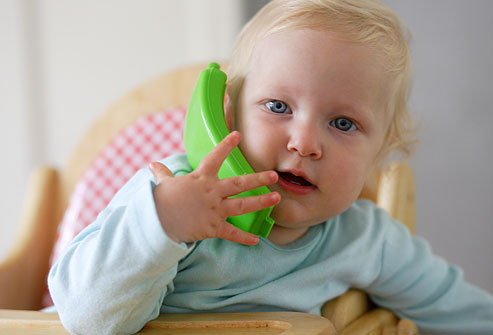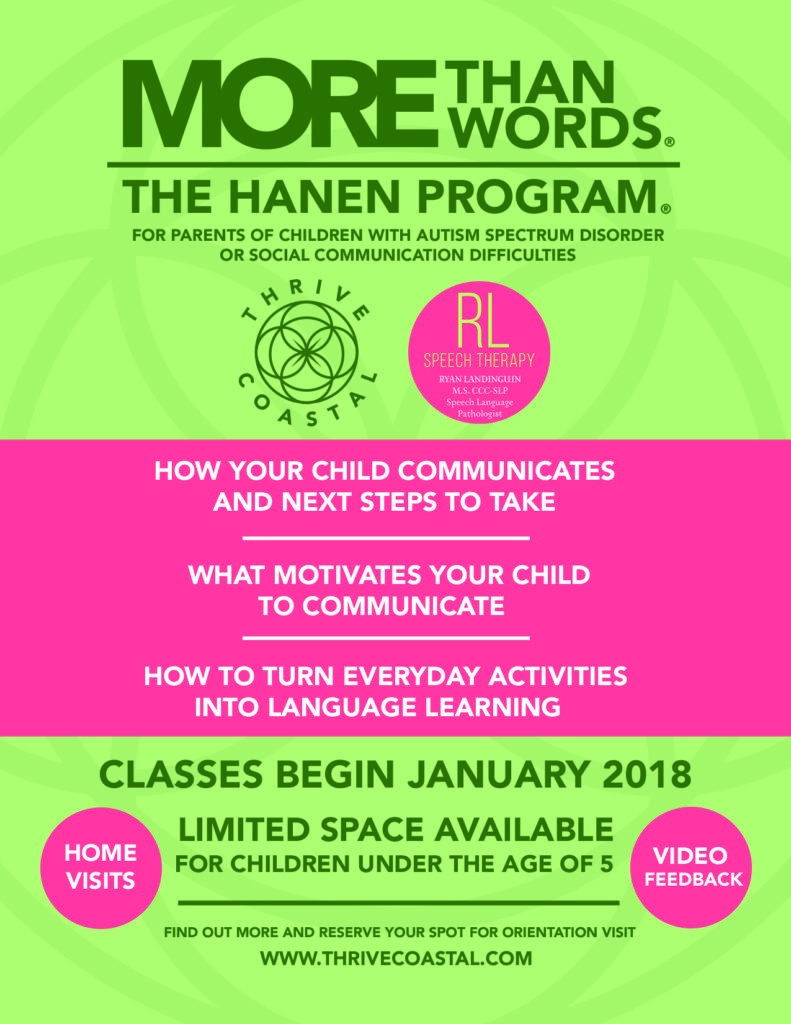Have you ever wondered if a child is “just a late talker” or if there’s a larger problem?
Research reveals that there are several risk factors that let us know that a child’s late talking is likely a part of a child’s developmental differences, rather than the only issue. I’ve started a series of articles to address this concern. In this post, we’re addressing the fourth red flag:
DECREASED PRETEND PLAY SKILLS
What is pretend play?
Pretend play skills are different from other kinds of early play we see in toddlers. Early play includes activities such as dumping objects in and out of containers, stacking blocks, pushing a car across the floor, or even brushing their hair with a toy brush. Those kinds of exploratory, constructive, and functional play skills are important and come first. Early play sets the stage for pretend play, but those early play activities are not the type of play that we’re discussing. Many parents (and some therapists!) miss this significant distinction.
Pretend play means just that… pretending.
During pretend play, a toddler begins to use his imagination. By looking at what she’s doing, she shows us what she’s thinking. Essentially, play is a cognitive skill.
If a child can’t tell us what he’s thinking and we can’t read his little mind, how do we know when a toddler is pretending? There are some important clues. Pretend play occurs when a child:
- Uses an object to represent another object. For example, a child may use an empty wipe box for a bed for a doll or a stick as a spoon to stir imaginary food.
- Assigns properties to an object. For example, she may blow on her plastic food as she pretends it’s “hot.” She may pretend that her teddy bear is crying and then comfort the bear with a hug or kiss as she says, “Shhhh, don’t cry” or “It’s okay.”
- Refers to invisible objects. For example, he may grip an invisible steering wheel as he pretends to drive his car or fight imaginary bad guys.
Why is pretend play important for language development?
Pretend play is an important marker for language development because when a child begins to pretend, we know that he’s becoming symbolic. He’s learned to use one object to represent another object.
That’s what words are – symbols. Words are symbols that represent objects, people, events, and even abstract concepts like emotions (happy, angry, or frustated) or physical states (hungry, tired, or hot).
When a child doesn’t substitute one item for another or pretend that he’s using something that’s not there, he’s not establishing the cognitive or mental foundation for using words meaningfully.
Diagnostic Implications for Decreased Pretend Play
Toddlers who don’t pretend with toys often have cognitive delays. Cognition is essential for language development. Remember that cognition means how a child thinks, learns, processes the language he hears, remembers events, pays attention, and plans his next move. We see a child do all those things as he pretends. Pretend play is real evidence that a child’s cognitive skills are developing and maturing.
A lack of pretend or imaginative play is also associated with autism. (For other diagnostic criteria for autism, take a look at my course Is It Autism? Recognizing and Treating Toddlers and Preschoolers with Red Flags for ASD.) Many times toddlers who go on to be diagnosed with autism do play, but upon closer inspection, you realize that all of their play activities are those earlier types of play we previously mentioned – exploratory, functional, or constructive.
Children with motor and muscle tone issues, such as cerebral palsy, may also have limitations in their pretend play because of the physical aspects of playing. Keep in mind that pretending is mostly a mental or cognitive exercise. Even when a child’s body movements are restricted, he can still use his imagination to pretend.
On the other hand, when a nonverbal toddler is obviously pretending during play, we don’t worry as much about their speech and language development. We know that the foundation for language is developing, even if words aren’t there yet!
Ways to Improve a Child’s Pretend Play Skills
You can help a child learn to pretend using a four step process. Last fall I devoted an entire podcast to this topic. For a full explanation, listen to the entire show here. Here’s a brief summary to get you started:
- Help a child learn to use familiar toys appropriately or functionally.
In other words, a child will begin to use a toy or an object in the way it is intended. For example, push a toy car, stack blocks, throw or roll a ball, read a book, pound a hammer, etc…
- Help a child learn to use objects herself.
It may help to think of this as “on” or “to” herself. Begin with familiar objects from daily routines:
- Everyday items – phone
- Dishes- cup, spoon, plate, bowl, fork
- Toy Foods – variety of plastic foods
- Bath & Sleeping Items – toothbrush, brush, washcloth, blanket, Band-Aids
- Early Dress Up – hats, shoes, glasses, gloves, backpack/purses/bags, crowns
- Help him learn to use objects on another person.
With all the items we’ve discussed, the next goal is to use the object on another person. For example, a child would try to give Mommy a drink from his cup or brush Daddy’s hair. Sometimes this step comes easily for a child and he will naturally begin to expand object use in this way. However, in some children with developmental delays, we’ll have to teach (even over-teach) this step. Keep at it! This is particularly challenging for children who don’t consistently include other people during play. (This may also be a red flag for autism.)
- Help her learn to combine objects in pretend play.
Combining objects means that a child will use more than one object together during play. For example, she will feed a baby doll with a bottle or cover a baby doll with a blanket.
If you introduce combining the objects with other things too soon, you may lose the child, so don’t rush it. I often see this is play when I’m introducing baby dolls. If the child is more interested in using the objects himself, then back up and play at this level for a while. This results in the child staying with you and interacting better.
This process of teaching early pretend play usually takes some time to develop. It likely will NOT happen in one session, or even over a couple of months, particularly for children with moderate to significant receptive language and/or cognitive delays. For specific toy suggestions, look at this post.
Recommendations for Parents
The most important recommendation I can make for parents of a child who is struggling with learning to pretend is to pursue professional assistance. Begin by discussing your concerns with your pediatrician or another healthcare professional. Ask for a referral to a speech-language pathologist or state early intervention program to evaluate your child’s overall language and cognitive skills. If your doctor dismisses your concerns, get another opinion! You know your child better than anyone else ever will. If you’re feeling uneasy about your child’s development, trust your instincts!
Early intervention is especially critical for a child who is not trying to communicate and not learning to play. As I’ve said in other posts in this series, maturity alone usually does not resolve these kinds of issues. By this I mean that a child won’t “grow out of it.” Intervention is absolutely necessary!
In early toddlerhood and throughout the preschool years, I believe that specialized developmental therapy services are critical. This period is when we can make the MOST difference in a child’s outcome. It’s when developing brains are most “ready” for growth.
Parents of a child with any kind of language delay will benefit dramatically from having a professional or team of professionals teach them ways to successfully address their own child’s needs at home. Therapy doesn’t need to be a once or twice a week thing when a child attends therapy or goes to preschool. By working with therapists and teachers who have had experience treating other children with similar backgrounds, you’ll be able to trust that you’re doing everything you can to help.
WRAP UP
In summary, a toddler who isn’t pretending during play may have difficulty acquiring a broad range of developmental skills including learning how to talk. These challenges may overlap into additional areas of development including a child’s cognitive and fine motor skills. Social skills will also be affected if a child doesn’t learn how to pretend so that she can pretend with friends as she gets to be preschool-aged.
Assistance when a child is young can be highly successful for significantly improving, and in some cases, even eliminating these problems.
If you’re a parent, I hope that this information will help you understand what may be going on with your own child.
If you’re a therapist, this is the kind of information that doctors and other professionals may not be sharing with parents of a child with a language delay. It’s up to us to help families understand the depth of a child’s issues and provide hope that therapy, along with consistent parental commitment, can make a huge difference!
Keep watching for additional posts in this series! Next we’ll discuss repetitive movements.
Laura
Product Recommendations from teachmetotalk.com for Helping Toddlers with Language Delays
Toddlers who don’t pretend during play will also have difficulty learning to understand and use language. My best resources for parents include:
Teach Me To Play WITH You is my first book written for both parents and professionals. In this therapy manual, you’ll learn my best tips for helping a toddler learn how to consistently interact with you during fun games and social routines. This can be the starting point for therapy for any child who isn’t playing yet because you’re teaching them the kinds of play that comes first. There’s an entire section on early play routines using familiar toys that most families already have in their homes. Each activity is written in a “homework format” with step-by-step instructions and goals that are clearly delineated. Parents and therapists who have used this method rave about how quickly they noticed changes in their toddler once they implemented these methods.
Teach Me To Talk the DVD focuses on expressive language or what a child says. In this DVD, you’ll see the 6 beginning strategies I teach parents of late talkers. The DVD is filled with video clips of children with a wide range of abilities from 12 months to 3 years. It’s a great starting place for most parents (and therapists!) who want to learn real life ways to work with a toddler with language delays. You’ll see lots of great examples for helping a child develop early communication skills during play.
If you’re more of a reader or if you want detailed goal lists for both receptive and expressive language matched with activities to use with toddlers and preschoolers, take a look at my book at Teach Me To Talk: The Therapy Manual. There are specific activities for teaching early play skills in several chapters. This book was written for speech-language pathologists, but many parents use it as their basis for “at home” therapy.
For therapists (and ULTRA committed parents who are working with their children intensely or parents who don’t have access to services and need professional-level information), my CE courses that best address early language skills or a lack of play are:
Is It Autism? Recognizing and Treating Toddlers and Preschoolers with Red Flags for ASD is a course on DVD. Part One entails a comprehensive look at the diagnostic criteria for autism so it takes some of the guesswork out of this process. If you’re a professional and find yourself wondering if a child would or wouldn’t get an ASD diagnosis, this course is for you! Part Two is all about intervention. You’ll learn the most effective treatment strategies and approaches to jump start progress in a toddler with red flags for autism. There’s a section on developing early play skills.
Early Speech-Language Development: Taking Theory to the Floor. In this comprehensive 12-hour course on DVD, all areas of language development (social, receptive, expressive, and intelligibility) are addressed. You’ll see lots of examples of toys and activities to improve early play skills.
Steps to Building Verbal Imitation in Toddlers is a course that outlines how to move a nonverbal child toward using words and phrases in a sequential, step-by-step approach. This course includes an entire section (it’s Level One) on teaching a child to imitate actions during play, which is the first step in learning to pretend.
All courses are approved for ASHA credit for speech-language pathologists (and if you’re in IL, it’s preapproved for EI credit!) with a certificate of completion for other therapists to use toward licensure or certification requirements.
Need a coupon code? Join my email list and you’ll get one! It’s on the last page of the FREE parent eBook. You’ll also get emails with the most current sales with coupon codes not published here on the site. Sign up in the green banner.
Links to Milestones
Follow these informative links to the Center for Disease Control website with lists of skills and pictures to show you what’s normal for a child’s age range. Remember that most babies will have easily achieved the skills listed there – meaning that the standards listed are set at a minimal level to account for a wide range of “normal.” (In other words, the bar is pretty low.) If a child hasn’t met all the skills on these lists or especially exhibits the concerns in the bottom “Act Early” boxes, there is a definite reason to speak to your child’s doctor or healthcare professional.
**Photo credit: sciencedaily.com**






Leave A Comment